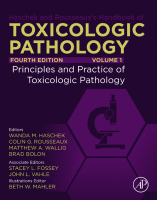Physical Address
304 North Cardinal St.
Dorchester Center, MA 02124

1 Introduction As an integral member of the preclinical study team, the toxicologic pathologist needs to have a thorough understanding of the laboratory animal model that serves as a test system for studies with pathology requirements. Genetic, microbial, experimental, and…

1 Introduction Toxicologic pathologists fill important roles in enabling the delivery of new medicines, chemicals, and other products that improve and save lives across the world. These include serving as study pathologists, peer review pathologists, sponsor pathologists, consultants, toxicologists, and…

1 Introduction Good Laboratory Practice (GLP) standards were authored by the United States Food and Drug Administration (FDA) to ensure sound and repeatable nonclinical safety assessment studies. They set the standard by which studies are planned, conducted, monitored, reported, and…

1 Introduction In vivo regulatory-type animal toxicity studies that include pathology endpoints are generally not hypothesis-driven experiments. Instead, these studies are meant to gather information using multiple, medical diagnostic endpoints, assessed both antemortem (i.e., in life) and postmortem, to discover or…

Acknowledgments The authors acknowledge previous authors of this chapter, Drs. Amy Brix and Ron Herbert. This work was supported in part by the NIH, National Institute of Environmental Health Sciences. 1 Introduction In general nonclinical toxicology studies conducted for hazard…

1 Introduction In 2007, the U.S. National Research Council (NRC) formally introduced a new paradigm in safety assessment and toxicity testing on behalf of a joint consortium of U.S. federal government agencies ( ; ). This “Tox 21” initiative highlighted…

Acknowledgments Some passages in this chapter were taken directly or slightly modified from the predecessor chapter entitled “Genetically Engineered Animals in Product Discovery and Development” as printed in Haschek and Rousseaux's Handbook of Toxicologic Pathology , 3rd edition, by permission…

Acknowledgments The authors would like to sincerely thank the following for their assistance in obtaining and preparing materials presented in this chapter: John Friel, Cornell University Museum of Vertebrates, Ithaca, New York, USA; Christiana Grim, OSCP/EPA, USA; Shelley Gruntz, EPL,…

1 Introduction At the time of writing this chapter, the Coronavirus (COVID-19/SARS CoV-2) pandemic of 2020 was in full progress without vaccines or viable treatments available to the public. Meanwhile, multiple research and toxicology studies involving nonhuman primates (NHPs) were…

1 Introduction The choice of animal species in nonclinical research should always be carefully considered and justified. Pigs and minipigs are considered good models for humans because they share many important characteristics. Swine exhibit particularly close resemblance to humans with respect…